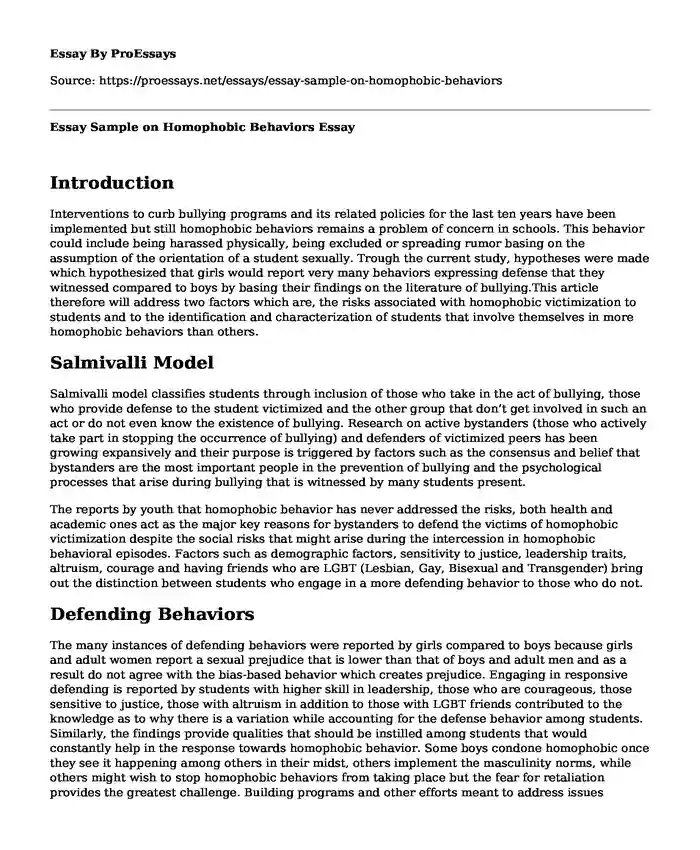Introduction
Interventions to curb bullying programs and its related policies for the last ten years have been implemented but still homophobic behaviors remains a problem of concern in schools. This behavior could include being harassed physically, being excluded or spreading rumor basing on the assumption of the orientation of a student sexually. Trough the current study, hypotheses were made which hypothesized that girls would report very many behaviors expressing defense that they witnessed compared to boys by basing their findings on the literature of bullying.This article therefore will address two factors which are, the risks associated with homophobic victimization to students and to the identification and characterization of students that involve themselves in more homophobic behaviors than others.
Salmivalli Model
Salmivalli model classifies students through inclusion of those who take in the act of bullying, those who provide defense to the student victimized and the other group that don’t get involved in such an act or do not even know the existence of bullying. Research on active bystanders (those who actively take part in stopping the occurrence of bullying) and defenders of victimized peers has been growing expansively and their purpose is triggered by factors such as the consensus and belief that bystanders are the most important people in the prevention of bullying and the psychological processes that arise during bullying that is witnessed by many students present.
The reports by youth that homophobic behavior has never addressed the risks, both health and academic ones act as the major key reasons for bystanders to defend the victims of homophobic victimization despite the social risks that might arise during the intercession in homophobic behavioral episodes. Factors such as demographic factors, sensitivity to justice, leadership traits, altruism, courage and having friends who are LGBT (Lesbian, Gay, Bisexual and Transgender) bring out the distinction between students who engage in a more defending behavior to those who do not.
Defending Behaviors
The many instances of defending behaviors were reported by girls compared to boys because girls and adult women report a sexual prejudice that is lower than that of boys and adult men and as a result do not agree with the bias-based behavior which creates prejudice. Engaging in responsive defending is reported by students with higher skill in leadership, those who are courageous, those sensitive to justice, those with altruism in addition to those with LGBT friends contributed to the knowledge as to why there is a variation while accounting for the defense behavior among students. Similarly, the findings provide qualities that should be instilled among students that would constantly help in the response towards homophobic behavior. Some boys condone homophobic once they see it happening among others in their midst, others implement the masculinity norms, while others might wish to stop homophobic behaviors from taking place but the fear for retaliation provides the greatest challenge. Building programs and other efforts meant to address issues concerned with masculine norms and identities and how they prevent one from being an active bystander is one of the major interventions towards countering this behavior by adolescent boys.
Observations of more homophobic behaviors and reporting of more defending behaviors were made by sexual minority student compared to heterosexuals. The hostility of the school environment in which the study was conducted led to the empowerment of the sexual minority students to counter this behavior even though they occupied an extreme marginalized social status. Sexual minority students may have victims of homophobic behaviors who are their friends through which they act as witnesses of observation of the behavior than heterosexuals. Sexual minority students are fully aware of how severe the experiences of homophobic victimization that is based by what themselves experienced. The experiences that sexual minority students have towards homophobic victimization could act as a catalyst in stopping such acts from happening to other people.
Students in leadership positions have less fear than other students due to high status. They get a lesser retaliation from others and hence leadership is seen as a defending behavior among students who have witnessed homophobic behavior. Hierarchical leadership when other qualities are included never gives a similarity to a defending role contributed the complexity in the connection between either taking part in homophobic behavior or going against it thus I recommend future studies to put into consideration the kinds of leadership styles in specific that has a correspondence with a defending behavior.
Students who are highly sensitive to justice associate homophobic behaviors as an unfair practice because they strongly feel affected by how bad the other person is experiencing . The combination of the homophobic behavior being an unfair practice and the personal feelings brought experiencing a homophobic behavior taking place builds up the morale among students to strongly intercede against such practices from happening again. As a future reference, researchers and educators should put into consideration how an effect a particular program has when increasing the behaviors of students defending during situations of Homophobic behavior.
Conclusion
It is therefore significant for psychologists, educators and interventionists to know and familiarize with how bystanders and youths who are against a homophobic behavior identify how best they can work with them in creation of respectful norms and the promotion of a safer school.
References
Poteat, V. P., & Vecho, O. (2016). Who intervenes against homophobic behavior? Attributes that distinguish active bystanders. Journal of school psychology, 54, 17-28.
Cite this page
Essay Sample on Homophobic Behaviors. (2024, Jan 01). Retrieved from https://proessays.net/essays/essay-sample-on-homophobic-behaviors
If you are the original author of this essay and no longer wish to have it published on the ProEssays website, please click below to request its removal:
- Ferguson Missouri Events in August 2015
- Research Paper on Gender Differences in Employment
- Essay Sample on Writing Portfolio
- Research Paper on Sex Differences in Mental Abilities
- Homeless and Veterans Essay Example
- Essay on Study on Alcohol Counseling Practices & Alcohol Consumption Rate in Medical Students
- Essay Example on Social Changes in American Society: Frederick Douglass & Sentimentalism







